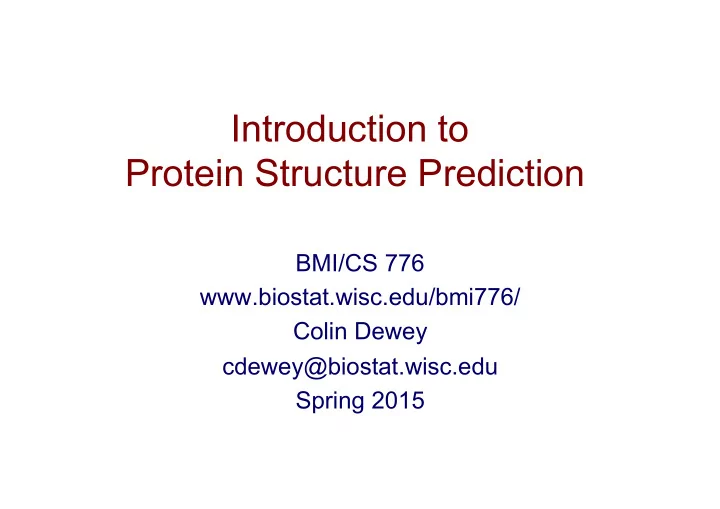

Introduction to Protein Structure Prediction BMI/CS 776 www.biostat.wisc.edu/bmi776/ Colin Dewey cdewey@biostat.wisc.edu Spring 2015
The Protein Folding Problem • we know that the function of a protein is determined in large part by its 3D shape ( fold , conformation ) • can we predict the 3D shape of a protein given only its amino-acid sequence?
Protein Architecture • proteins are polymers consisting of amino acids linked by peptide bonds • each amino acid consists of – a central carbon atom (alpha-carbon) – an amino group, NH 2 – a carboxyl group, COOH – a side chain • differences in side chains distinguish different amino acids
Amino Acids and Peptide Bonds amino side carboxyl group chain group α carbon (common reference point for coordinates of a structure)
Amino Acid Side Chains side chains vary in – shape – size – charge – polarity
What Determines Conformation? • in general, the amino-acid sequence of a protein determines the 3D shape of a protein [Anfinsen et al., 1950s] • but some qualifications – all proteins can be denatured – some proteins are inherently disordered (i.e. lack a regular structure) – some proteins get folding help from chaperones – there are various mechanisms through which the conformation of a protein can be changed in vivo – post-translational modifications such as phosphorylation – prions – etc.
What Determines Conformation? • Which physical properties of the protein determine its fold? – rigidity of the protein backbone – interactions among amino acids, including • electrostatic interactions • van der Waals forces • volume constraints • hydrogen, disulfide bonds – interactions of amino acids with water • hydrophobic and hydrophilic residues
Levels of Description • protein structure is often described at four different scales – primary structure – secondary structure – tertiary structure – quaternary structure
Levels of Description the amino acid sequence itself “local” description of structure: describes it in terms of certain common repeating elements 3D conformation 3D conformation of a complex of of a polypeptide polypeptides
Secondary Structure • secondary structure refers to certain common repeating structures • it is a “local” description of structure • two common secondary structures α helices β strands/sheets • a third category, called coil or loop , refers to everything else
Ribbon Diagram Showing Secondary Structures
Determining Protein Structures • protein structures can be determined experimentally (in most cases) by – x-ray crystallography – nuclear magnetic resonance (NMR) • but this is very expensive and time-consuming • there is a large sequence-structure gap ≈ 550K protein sequences in SwissProt database ≈ 100K protein structures in PDB database • key question: can we predict structures by computational means instead?
Types of Protein Structure Predictions • prediction in 1D – secondary structure – solvent accessibility (which residues are exposed to water, which are buried) – transmembrane helices (which residues span membranes) • prediction in 2D – inter-residue/strand contacts • prediction in 3D – homology modeling – fold recognition (e.g. via threading) – ab initio prediction (e.g. via molecular dynamics)
Prediction in 1D, 2D and 3D predicted secondary structure and solvent accessibility known secondary structure (E = beta strand) and solvent accessibility Figure from B. Rost, “Protein Structure in 1D, 2D, and 3D”, The Encyclopaedia of Computational Chemistry, 1998
Prediction in 3D • homology modeling given: a query sequence Q , a database of protein structures do: • find protein P such that – structure of P is known – P has high sequence similarity to Q • return P’s structure as an approximation to Q ’s structure • fold recognition (threading) given: a query sequence Q , a database of known folds do: • find fold F such that Q can be aligned with F in a highly compatible manner • return F as an approximation to Q ’s structure
Prediction in 3D • “fragment assembly” (Rosetta) given: a query sequence Q , a database of structure fragments do: • find a set of fragments that Q can be aligned with in a highly compatible manner • return fragment assembly as an approximation to Q ’s structure • molecular dynamics given: a query sequence Q do: use laws of Physics to simulate folding of Q
Prediction in 3D homology fragment assembly molecular modeling threading (Rosetta) dynamics
“Citizen science” • Folding@home http://folding.stanford.edu Molecular dynamics simulations • Rosetta@home http://boinc.bakerlab.org structure prediction Volunteer/distributed computing
Foldit http://fold.it/
Recommend
More recommend